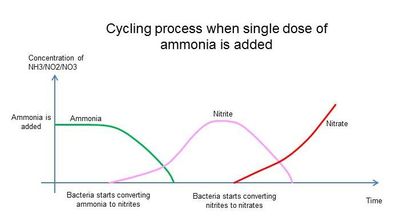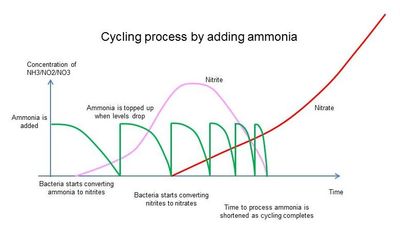Your Cart is Empty
Menu

Should I bother cycling a planted tank before planting? Introducing the dark start.
July 21, 2025 6 min read

Tank cycling is important for a few reasons.
The reasons for cycling a tank before plants are added are not immediately apparent to new aquarists, especially since tank cycling has traditionally only been connected with fish health. However, cycling a tank before planting reduces both algae and plant melting occurring. This is most impactful for aquariums using higher light levels and/or sensitive plants. Diatoms and green dust algae are common in new setups. It is so common that many experienced aquarists think it is an inevitable stage that all tanks must go through, but we can skip most of the troubles associated with a new tank settling in if we allow it to mature before planting.
What makes a mature tank so much more stable than a fresh installation is the microbial population that develops in the aquarium's ecosystem as the aquarium matures. Organic waste coupled with high light levels is the prime trigger for algae blooms. Microbes digest these organic waste and also directly consume algae. Beneficial microbes also outcompete pathogenetic microbes that attack newly added plants that are going through transition stress. Most plants adapt better when added to an aquarium that has matured biologically, this is especially so for more sensitive plant species.
The microbial community takes time to build up in an aquarium, and actions that can speed up the maturity of the tank will help greatly.
 This tank from Nate B. demonstrates a spectacular diatom bloom. This did not occur due to neglect. Diatoms multiple quickly when light and nutrients are plentiful in a biologically immature tank.
This tank from Nate B. demonstrates a spectacular diatom bloom. This did not occur due to neglect. Diatoms multiple quickly when light and nutrients are plentiful in a biologically immature tank.Ammonia is great as plant food ?
Ammonia is an excellent source of nitrogen for plants, which generally use less energy to synthesise nitrogen from ammonia than from nitrates. Ammonia binds to clays and organic matter in the substrate, and plants that can obtain nitrogen from an ammonia-rich substrate grow better and more robustly.
However, ammonia in the water column can exacerbate algae problems and affect delicate plant species. Allowing the tank to cycle and removing excess ammonia before planting will provide a more stable environment for the plants to settle into.
 Bucephalandra require a stable, clean, well filtered environment to do well long term. This easy plant often melts in new setups. They are best added after the aquarium has matured sufficiently.
Bucephalandra require a stable, clean, well filtered environment to do well long term. This easy plant often melts in new setups. They are best added after the aquarium has matured sufficiently.
Reduced toxicity of ammonia below pH 7?
In biological systems, ammonia can occur in two forms - ionised (NH4+) and unionised (NH3). The amount of ammonia present in either form is largely dependent on the pH range of the aquarium. Ionised ammonia (NH4+) is much less toxic. Therefore, the toxicity of ammonia is greatly reduced in lower pH environments as most of the ammonia present will be in the form of ionised ammonium (NH4+). In aquasoil tanks where high levels of ammonia are emitted, one can avoid most of the disadvantages of elevated ammonia due to the strong buffering capacity of the soil which lowers the pH below 7.

Tank cycling The old way
The old method of cycling a planted tank was to add a light load of hardy fish, which produce organic waste and ammonia, and then leave the tank to build up the bacteria naturally over time. This could take many weeks as more and more animals were slowly added. This method has worked very well in the past as long as regular water changes are made to prevent large ammonia build ups. However, it has also been criticised for being cruel - and although fish may not show outward signs of stress, it can still affect their organ health and lifespan if ammonia levels are not carefully monitored.
Seeding the tank with seasoned filter media or mulch from a previous set-up are both good ways to kick start the cycle.

Sensitive plant species are more prone to getting attacked by algae in a biologically immature tank. Species such as Utricularia and Bucephalandra grow much better when added after the tank has matured.

Sensitive species such as tissue culture plants and Hygrophila chai grow adapt much better when added to biologically mature aquariums.
Today's fish-less cycling
Nowadays, fish-less cycling with plants is the rage. This involves adding liquid ammonia regularly into a new tank; fully setup except for livestock or plants, to grow the bacteria colonies. Follow these 3 steps:
-
A dose of 2ppm ammonia is added, then the water is tested after a few days (it takes about 3 days from a cold start to see any change at all). When the ammonia levels start to drop, you would see a build-up of nitrite. The first step of the ammonia oxidation cycle has started (but not necessarily completed).
-
Additional ammonia is then added each day to feed the bacteria (enough to bring the levels back up to around 2ppm). After many more days the nitrite levels would fall and you can then measure the rise in nitrate levels as the bacteria that convert nitrite to nitrate have colonised. This will take longer than step 1 because the bacteria responsible for converting nitrite to nitrate are slower to populate.
-
Eventually, even with the addition of ammonia, nitrites and ammonia would be measured at 0 after 6 hours, while nitrates would accumulate. The ammonia cycling process for the tank is now complete. The whole process can take 4-6 weeks depending on the tank parameters.
Typically, we would change 80% of the tank water to reduce nitrates before adding animals. Adding starter bacterial cultures at step 1 speeds up the process considerably. Bacterial products work, but many are sensitive to temperature. Depending on how they are transported and stored, cultures can be DOA (dead on arrival). This is the main risk/disadvantage of bacterial products.


Cycling with aquasoils (Dark start):
-
If you are not using starter bacteria products, it is a good idea to add mulm or used filter media to get the cycle started. Without the use of starter bacteria products, a full tank cycle can take up to a month or more. The lowered pH of the tank water due to the buffering capacity of Aquasoil reduces ammonia toxicity as most of the ammonia is present in the less toxic ammonium (NH4+) format at low pH (below 7). This allows hardy plants to be planted and grown at early stages where ammonia levels are detectable. However, more sensitive plants such as Utricularia gramminifolia, and tissue culture plants in general, should not be planted until the tank has been cycled - they melt easily in fresh soil.
-
With the use of starter bacteria products, cycling time can be shortened to a week plus. After filling the tank, we recommend letting the tank soak for a couple of days without running the filter. On the second or third day, do a 100% water change then start running the filter. This removes organic debris, dust and sugars released from the woods and prevent the filter from taking up a lot of debris at the start. After starting the filter, dose the starter bacteria culture into the filter intake. We would increase the KH to 3dKH and add a few pieces of limestone (about 200 grams of Seiryu per 100 litres) temporarily to the tank to prevent tank water from becoming too acidic if the water is super soft.
-
Wait 4 days and take ammonia and nitrate readings. If there are nitrate readings, it means that the cycling has started. However, due to the tremendous amount of ammonia the aquasoil releases, chances are ammonia readings will still be high. Do a 90% water change and dose another dose of starter bacteria culture.
-
Wait a day and take ammonia/nitrate readings. If the ammonia reading is 0 and the nitrate reading is positive, the tank has cycled. However, if soil loading is high, the ammonia reading may still be positive as the soil releases a lot of ammonia, in which case wait a few days and repeat step 3. Due to the reduced toxicity of ammonia below pH 7, which is generally the case in aquasoil tanks, standard, non-delicate plants can be planted as long as ammonia levels are low (below 0.5ppm or so). However, for sensitive animals such as shrimp, it is better to wait until the tank is fully cycled.

Biological maturity of planted aquariums is important with regards to both plant health and avoiding algae. Beginners take it for granted while experienced aquarists know that it is a key factor to success.
In the setup videos on Youtube, folks seem to plant immediately in fresh aquasoil ?
The type of plants and aquasoil used is very important. Hardier plants can be used in a fresh set up without too much of a downside.
What you also don't see is the daily water changes, replacement of melted plants and algae cleaning that goes on behind the scenes. Hardy species planted directly into fresh soil will generally recover, even if they take the initial hit from the uncycled tank. However, for many beginners who do not have good control of their CO2 and other growth parameters, this could result in the loss of entire batches of plants.
For planting immediately without cycling follow this guide instead.
unlock your true potential
Grow anything, defeat algae, create amazing aquascapes
























